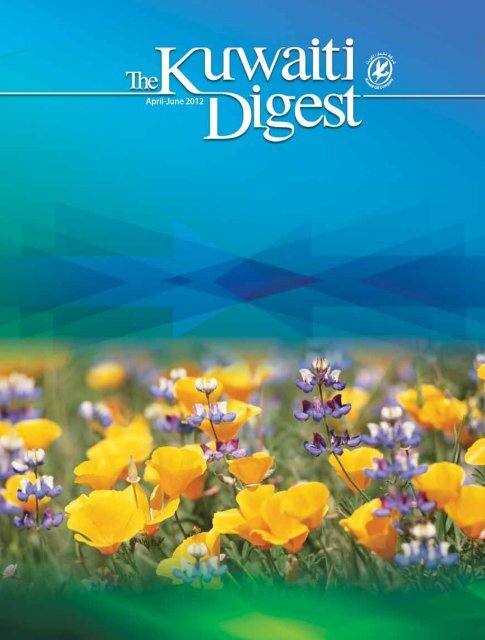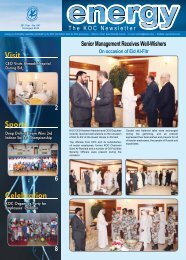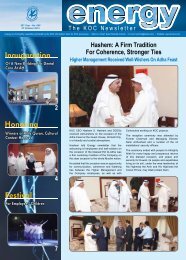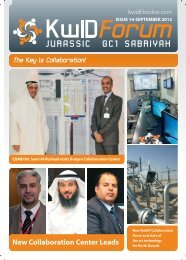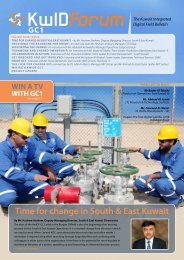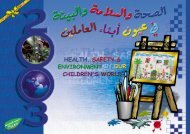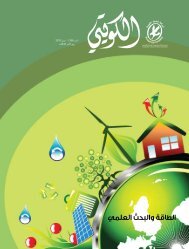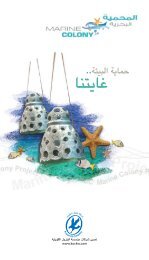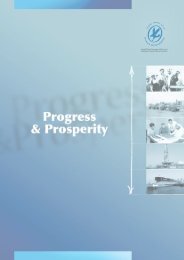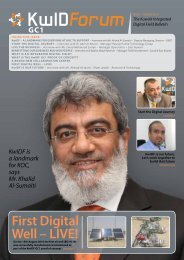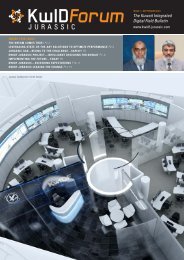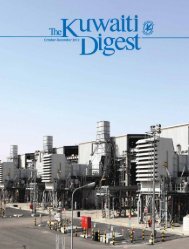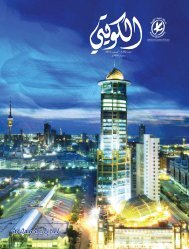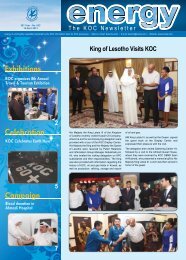8 - Kuwait Oil Company
8 - Kuwait Oil Company
8 - Kuwait Oil Company
Create successful ePaper yourself
Turn your PDF publications into a flip-book with our unique Google optimized e-Paper software.
April - June 2012The <strong>Kuwait</strong>i Digest isa quarterly magazinepublished by the <strong>Kuwait</strong><strong>Oil</strong> <strong>Company</strong> (K.S.C.)since 1973.The <strong>Kuwait</strong>i Digestinvites newspaper,magazine and tradejournal editors to reprintor otherwise make useof articles or illustrationsappearing in this issue.Material should becredited and a copymailed to the <strong>Kuwait</strong> <strong>Oil</strong><strong>Company</strong>.Produced byAl-Nazaer Printing PressPublishing & Distributing Co. w.l.l.Tel: 24744741 - Fax: 24716993Editor-in-ChiefKhaled Madhi Al-KhameesDeputy Editor-in-ChiefAbdul Khaleq Al-AliCorrespondence concerningThe <strong>Kuwait</strong>i Digest should be addressed to:Editor-in-Chief, <strong>Kuwait</strong> <strong>Oil</strong> <strong>Company</strong> (K.S.C.)Information TeamP.O. Box 9758Ahmadi 61008, <strong>Kuwait</strong>Telephone: 965-2398-2747Facsimile: 965-2398-1076E-mail: kocinfo@kockw.comor visit the KOC homepage athttp://www.kockw.com8<strong>Kuwait</strong> <strong>Oil</strong> & Gas Summit 2012
3<strong>Kuwait</strong> HostsInternationalEnergy ForumContentsLetter from the Editor 2<strong>Kuwait</strong> Hosts International Energy Forum 3KPC Board Members Visit KOC Sites 6<strong>Kuwait</strong> <strong>Oil</strong> & Gas Summit 2012 8KOC Organizes First Technology Day 12Arab <strong>Oil</strong> & Gas Magazine: Al-Zanki, Al-Rushaid andHashim among 50 Most Powerful in ME <strong>Oil</strong> & Gas 164th Town Hall Meeting & Exhibition betweenKOC & Contractors 18ASSE Organizes 6th International HSSE andLoss Prevention Conference & Exhibition 20KOC Participates in 5th IPTC 24Safeguarding Network Data 26WK Water Handling Lab Implements LIMS 30KOC’s Environmental Achievements 323rd Annual Production Optimization Middle East Summit 3418 204th Town HallMeeting & Exhibitionbetween KOC &ContractorsASSE Organizes 6thInternational HSSE andLoss PreventionConference &ExhibitionEnterprise Risk Management 36Decades of Service 40Hi-Tech 42TETRA: TErrestrial Trunked RAdio 44Meningitis 4724 KOC Participates in 5th IPTCMiswak 48
Khaled Madhi Al-KhameesDeputy Managing DirectorAdministration and FinanceThe first quarter of 2012 has proven to be a very eventful time for KOC.In addition to the various internal events and meetings held throughoutthe <strong>Company</strong>, many of our employees were active participants in anumber of international conferences that took place here in <strong>Kuwait</strong>.From the 2nd <strong>Kuwait</strong> <strong>Oil</strong> and Gas Summit to the <strong>Kuwait</strong> InsulationConference and Exhibition, KOC employees shared their expertise,knowledge and experiences with both a local and international audience.However, perhaps the most important of these events was the mostrecent one - the International Energy Forum - which attracted ministersof oil from around the world and took place under the patronage of HisHighness the Amir of <strong>Kuwait</strong> at Bayan Palace.The first quarter was also a time for KOC to celebrate variousachievements. A campaign launched within Ahmadi highlighted KOC’ssuccess in reducing gas flaring from 17% to 1.75%, and the environmentaland economic ramifications of this extremely significant achievementwill leave a positive impact on <strong>Kuwait</strong> for years to come. In addition,a number of senior KOC officials received international recognition fortheir contributions to the <strong>Company</strong> and <strong>Kuwait</strong>.Of course, any discussion of the first quarter would by no means becomplete without mentioning <strong>Kuwait</strong>’s National and Liberation Daycelebrations. As part of Ahmadi’s annual preparations for the occasion,the city was decorated with its iconic light fixtures and decorations,attracting both local residents and those who live far from Ahmadi tocome enjoy the festivities and celebrations.Naturally, we expect the next quarter to see progress in terms ofexploration and development. In order to meet our 2030 Strategy andattain the production goal of 4 million BOPD by 2020, KOC will continueto stay abreast of the latest technologies in the industry while activelypursuing the most efficient methods of exploration and development. Atthe same time, we will ensure to continue doing everything in our powerto protect the environment and the public’s safety.2April-June 2012
<strong>Kuwait</strong> Hosts InternationalEnergy ForumKPC CEO Farouk Al-Zanki and Minister of <strong>Oil</strong> Hani Hussein at the forumThe 13th International Energy Forumrecently took place in <strong>Kuwait</strong> underthe patronage of His Highness theAmir Sheikh Sabah Al-Ahmed Al-JaberAl-Sabah. The two-day event, whichbrought together some of the world’smost prominent energy ministers andindustry leaders, took place from March12-14 and was held at Bayan Palace andthe Regency Hotel, <strong>Kuwait</strong>.The goal of the International EnergyForum (IEF) is to foster greater mutualunderstanding and awareness ofcommon energy interests among itsmembers. The 88 Member Countriesof the Forum, which includes <strong>Kuwait</strong>,are signatories to the IEF Charter, whichoutlines the framework of the globalenergy dialogue through an inter-governmentalarrangement. The IEF’s biennialMinisterial Meetings are the world'slargest gathering of Energy Ministers,and the magnitude and diversity of thisengagement is testament to the positionof the IEF as a neutral facilitator andhonest broker of solutions in the commoninterest.During his opening remarks to the IEFForum at Bayan Palace, HH the Amirsaid, “<strong>Kuwait</strong> has actively endeavoredto bring constructive dialogue betweenenergy producing and consuming nationsever since the forum’s inceptionin Paris in 1991.” HH the Amir addedthat <strong>Kuwait</strong>, which is a member of theForum’s Executive Council, understoodthe importance of the forum as a viablevehicle for purposeful dialogue betweenenergy producing and consumingnations.HH the Amir also added that <strong>Kuwait</strong>places great importance in forums suchas the IEF, which he said bring togetherconsuming and producing nations,national energy companies and internationaloil firms in addition to worldorganizations that focus on oil andenergy issues. It is for this reason, hesaid, that <strong>Kuwait</strong> strongly believes in theexchange of expertise and viewpointson energy issues.<strong>Kuwait</strong>'s dedication to dialogue onenergy issues is manifested in its visiblerole in OPEC, which pursues a policyof stabilizing oil prices and supplyingenergy to international oil markets atmanageable prices, which enables producingcountries to utilize oil revenuesin their economic growth and futuredevelopment plans, HH the Amir said.However, HH the Amir also maintainedthat the international oil industry mayface great challenges in the near futurethat may be triggered by changes in theprice of oil, economic downturns, thethreat to safe open-sea navigation andthe need for enormous investment inthe energy sector to counter increasingdemand for energy.Despite these challenges, HH the Amirnoted that <strong>Kuwait</strong> envisioned a futureApril-June 20123
International delegates participated in the forumwhere oil wealth could be used torealize objectives of sustainable developmentand growth, with an emphasison nurturing human resources. At thesame time, however, HH the Amir saidthat protecting the environment throughthe judicious use of oil in an environmentally-friendlymanner and workingtoward the production of alternativeenergy sources was also an importantpriority for <strong>Kuwait</strong>.HH the Amir concluded his speech tothe international and local dignitaries byasking the participants to seek workablesolutions that induce stability in worldoil markets. He also asked for furthercooperation to be displayed betweenenergy consuming and producing nationsand between oil companies andenergy research centers.Meanwhile, the newly-appointed Ministerof <strong>Oil</strong> and former Deputy Chairmanand Chief Executive Officer of KPC,Hani Hussein, spoke about a rangeof issues, including the importance ofconsolidating efforts of energy producingand consuming countries in orderto guarantee clean and secure energy topeople around the world."We are proud of the fact that <strong>Kuwait</strong>is hosting this distinctive event whichculminates 20 years of dialogue, andis considered the first since signing theforum's charter. We are pleased by thisgreat participation of 600 people whorepresent 76 countries, 15 internationalorganizations, and 32 oil companies,"the minister said."The last 20 years have witnessedremarkable development in termsof dialogue between producers andconsumers, in which the InternationalEnergy Forum had a prominent rolein bringing points of view closer andcreating a climate of joint understandingbetween producers and consumerson various energy issues," the Ministerof <strong>Oil</strong> said, adding, “The importance ofthis forum is highlighted by its coincidingwith essential political and economicdevelopments that influenced thestability of energy markets, oil prices,and global economy recovery.”“Our interest in dialogue stems fromthe vital role of energy in all aspectsof our daily life, as well as it being themain engine of the global economy. Itis our responsibility to provide cleanand secure energy, which requiresconsolidating efforts of consuming andproducing countries to find appropriateeconomic resolutions in order toguarantee the well-being of humanswherever they are," he said.In an effort to demonstrate its supportfor energy and environmental issues,the minister told the audience thatHH the Amir recently announced that<strong>Kuwait</strong> would donate $150 million tosupport a program that will financescientific research related to energy, theenvironment, and climate change.In addition, the Minister of <strong>Oil</strong> also said,"Our vision is to use our oil wealth forsustainable development, with some ofthese main goals being the guarantee ofa promising future for our people to improvetheir professional and educationalcapabilities. At the same time, we willwork on protecting the environmentand reducing climate change."At the conclusion of his speech, the4 April-June 2012
A group photo of the participantsminister said, “We face big challenges.Resolutions may be difficult, but theyare not impossible. Therefore, we wishto take this opportunity to proposeresolutions and mechanisms that willcontribute in stabilizing energy marketsand create an environment of trust thatwill boost cooperation between producingand consuming countries, as wellas oil companies and scientific researchcenters for the good of all human beings."After the opening remarks and initialspeeches, the International EnergyForum was divided into four main sessions.The first session was titled “MeetingFuture Energy Demand: Planning andinvestment for the long-term.” Duringthis session, ministers were invited todiscuss desirable developments of allenergy sources and associated energyinvestment requirements that can leadto the achievement of a more sustainableenergy mix.The second session was titled “Energymarkets: Mitigating volatility.” Duringthis session, ministers were invited todiscuss developments in data transparency,energy market and volatility issuessince the 12th IEF and to offer guidanceon priorities for the future.“Achieving Environmental and SocialSustainability: Lower Emissions andAccess for All” was the title of the thirdsession, and ministers were invited todiscuss ways of achieving global energysecurity in a way that is compatiblewith environment preservation andclimate change mitigation.The last session was titled “The GlobalEnergy Dialogue: Charting the Futureof Energy Cooperation.” Duringthis session, Ministers were invited todiscuss how the implementation of theIEF Charter could help strengthen theproducer-consumer dialogue, narrowingthe differences among energyproducing, consuming and transitMember States on global energy issuesand promoting a fuller understandingof their interdependency and thebenefits to be gained from cooperationthrough dialogue among them, as wellas between them and energy-relatedindustries.About the IEFThe IEF, which counts member statesfrom all six continents and accounts for90% of global supply and demand foroil and gas, is unique in that it comprisesnot only consuming and producingcountries of the IEA and OPEC, but alsoTransit States and major players outsideof their memberships, including Argentina,Brazil, China, India, Mexico, Oman,Russia and South Africa. Sitting alongsideother important developed and developingeconomies on the 31 strong IEFExecutive Board, these key nations areactive supporters of the global energydialogue through the IEF.The IEF is the neutral facilitator ofinformal, open, informed and continuingglobal energy dialogue. Recognizingtheir interdependence in the field ofenergy, the member countries of the IEFcooperate under the neutral frameworkof the Forum to foster greater mutualunderstanding and awareness of commonenergy interests in order to ensureglobal energy security.Through the Forum and its associatedevents, IEF Ministers, their officials,energy industry executives, and otherexperts engage in a dialogue of increasingimportance to global energy security.The IEF and the global energy dialogueare promoted by a permanent Secretariatof International Staff based in the DiplomaticQuarter of Riyadh, Saudi Arabia. •April-June 20125
KPC Board Members Visit KOC SitesKOC officials and KPC board members meet at the <strong>Kuwait</strong> OasisMembers of the Board from KPCrecently visited a number of KOCsites in the accompaniment ofChairman and Managing DirectorSami Al-Rushaid. A number of DMDsand managers from South and East<strong>Kuwait</strong> were also in attendanceduring the daylong tour whichtook KPC officials to a number ofsites, including Rig SP-185 at Burgan<strong>Oil</strong> Field and various productionfacilities throughout the <strong>Company</strong>.Members from the visiting delegationincluded the DMD for Council andCommittee Affairs who is also the KPCBoard Secretary, Bader Al-Sharrad.Other delegation members includedSheikh Dr. Khalifah Al-Athbi Al-Sabah,Saad Al-Wasmi, Abdulwahab Al-Wazzanand Ahmad Al-Adsani.While on their visit, members fromthe delegation listened to detailedexplanations of the sites from KOCofficials. For their part, the KPC officialsexpressed their satisfaction with thecapabilities and progress of KOCPG Manager Shafiqa Mubarak delivers apresentationfacilities and personnel.During the tour, KOC officials toldthe visiting delegation about theachievements and progress the<strong>Company</strong> had made in relation to the2030 Strategy. They were also briefedon the challenges facing KOC and the<strong>Company</strong>’s plans to implement solutionsthat will make the realization of sharedgoals between KPC and KOC a reality.The visiting delegation began theirtour at Rig SP-185 in Burgan wherethe Manager for Development DrillingGroup, Ayad Al-Kandari, madea detailed explanation about thecompany’s oil fields and wells. He alsoprovided insight into the geologicalfeatures of <strong>Kuwait</strong> and provided anoverview of the costs associated withoil wells at different stages and thepreparations needed for each well.Al-Kandari also explained that someoperations require the involvementof local and international expertisethroughout various stages. Members ofthe delegation expressed their interestin the information provided by theDevelopment Drilling Group Manager,who reminded them that Burgan <strong>Oil</strong>Field is the second largest field of itskind in the world and that it is still oneof the largest producing oil fields in theworld despite it first being tapped for oilin 1938.At Gathering Center 19, the Managerof Operations (East <strong>Kuwait</strong>), EmadSultan, briefed the delegation about the6 April-June 2012
gathering centers throughout KOC andthe way they operate. Sultan told thedelegation that the Gathering Centershave been equipped with the latesttechnologies that allow staff to keeptrack of and monitor developments inthe fields around the clock.Meanwhile, Planning GroupManager Shafiqa Mubarak delivereda presentation about KOC’s strategywhich highlighted the achievementsand challenges that lie ahead for the<strong>Company</strong>. Also, Planning Team Leader(WK) Rima Al-Awadhi delivered apresentation to the visiting delegationabout a project aimed at improvingmaritime facilities.In a statement he made during thetour, Abdulwahab Al-Wazzan, aKPC board member, described thecompany’s facilities as outstanding.Regarding his impression of the tour,Al-Wazzan maintained that one couldonly appreciate the efforts of those inthe field after they actually becameacquainted with the sites. Al-Wazzanalso commended the tireless efforts ofthe top management from KOC andexpressed his admiration for the <strong>Kuwait</strong>Oasis, which was constructed in theheart of the desert on a location that waspreviously environmentally devastatedduring the Iraqi invasion of <strong>Kuwait</strong>.Meanwhile, members of the KPCdelegation welcomed information theyreceived that maintained <strong>Kuwait</strong>’s oilproduction had exceeded 3 millionbarrels per day. The achievement ofthis milestone, they said, puts KOC ontrack to the production goal of 4 millionbarrels of oil per day by 2020. Thenext step of this process would be tomaintain those levels until 2030 in orderto achieve the stated KPC strategy.The delegation also expressedsatisfaction with the presence of <strong>Kuwait</strong>imanpower at various sites throughout<strong>Kuwait</strong>, including female engineerswho work in the fields. For his part,C&MD Sami Al-Rushaid stated that KOCmanagement was happy to ensure thevisiting delegation visited importantlocations throughout KOC and wasOfficials were given a tour of the GC-19 Control RoomDDG Manager Ayad Al-Kandari delivers a presentation at Rig SP-185A group photo of KPC board members and KOC officials at Rig SP-185provided with relevant informationabout current KOC projects and futuregoals. C&MD Sami Al-Rushaid alsoaffirmed the company’s commitment tohealth, safety and the environment andassured the delegation that the wellbeingof KOC employees was one of the<strong>Company</strong>’s top priorities. •April-June 20127
<strong>Kuwait</strong> <strong>Oil</strong> & Gas Summit 2012KOC Chairman Sami Al-Rushaid and KGOC Chairman Hashim Al-Rifaai on the opening day of the summitKPC recently hosted its secondannual <strong>Oil</strong> and Gas Summit atthe Regency Hotel from February12 – 15. The summit, which is<strong>Kuwait</strong>’s largest conference ofits kind, builds on the successof KPC’s inaugural event of thesame name which was held in2011. This year, however, the <strong>Oil</strong>and Gas Summit also featured anexhibition which ran parallel tothe conference which displayedoil industry-related servicesoffered by both local andregional companies. In addition,the exhibition also featured anumber of technical sessionswhere presentations were givenfrom those within the industry.KPC CEO Farouk Al-Zankiand other senior officials from<strong>Kuwait</strong>’s oil industry inauguratedthe opening of the exhibition onFebruary 12 and were given atour of the booths and stands thatwere set up for the occasion. Thefollowing morning, the KPC CEOoffered his introductory remarksto the audience and outlinedKPC’s current and projectedoperations, which included adiscussion of KPC’s StrategicPlan for 2030. In his speech, Al-Zanki maintained that “<strong>Oil</strong> andgas will continue to play a majorrole in global energy needs,” andadded that “<strong>Oil</strong> dependency willcontinue past the year 2030.”However, the CEO also notedthat although oil is the country’smost important resource, “<strong>Kuwait</strong>must consider diversification fordifferent sources of income.”A brief outline of the importantpoints the KPC CEO discussedwhich set the tone of theconference are as follows:• In addition to regularoperations, KPC will continueto work towards the reductionof emissions for a cleanerenvironment for futuregenerations.• KPC will focus on upstreamoperations with the goal ofincreasing production by125,000 barrels annually untilthe 4 million BOPD target is8 April-June 2012
KPC CEO Farouk Al-Zanki inaugurating the exhibitionreached by 2020.• As oil and gas operationsexpand, a focus onoperational excellencemust be implemented inorder to avoid unnecessarymaintenance costs and loss ofproduction.• <strong>Kuwait</strong>i nationals willcontinue to be recruited;however, highly qualified andexperienced professionals areneeded for KPC’s future goals,which necessitates the need toalso hire expatriates as thereare not enough <strong>Kuwait</strong>is to berecruited.• The Strategic Plan for 2030has a focus on the humanelement: Nationals will berecruited, trained and havetheir skills developed whilecreating an environment thatencourages retention and thecreation of loyalty.• Joint work throughoutKPC subsidiaries will beencouraged in order toenhance better cooperation,knowledge transfer and bestpractices.• The adoption of newtechnologies will continue asthey become available.• Knowledge sharing andcooperation among oilcompanies, governments andother sectors will be necessaryfor the industry to flourishand achieve its full potential.Following the KPC CEO’s messageto the audience, KOC Chairman& MD Sami Al-Rushaid hosteda session titled “Optimizing<strong>Kuwait</strong>’s Resource Potential.”Before introducing the speakers,Al-Rushaid delivered a speech tothe audience titled “New Solutionsfor the Energy Balance in <strong>Kuwait</strong>.”In his talk, the KOC Chairmandiscussed the future challengesfacing <strong>Kuwait</strong>’s energy needs,particularly in the area of energyconsumption from a growingpopulation.“In the past five years, energyconsumption in <strong>Kuwait</strong> has grownby 1.5% annually. However, thisApril-June 20129
is expected to grow to an annualrate of 2.8% in the coming years,”Al-Rushaid said, adding that by2030, energy consumption in<strong>Kuwait</strong> was “Expected to reachthe equivalent of 1 millionBOPD.”Supplying this energy for afuture population, he said,will be a major challenge for<strong>Kuwait</strong>. However, in order to dothis, KOC has plans to increaseits production from 3 millionBOPD to approximately 3.65million BOPD by 2020, andthen sustaining this productionthrough the year 2030. However,the KOC Chairman also notedthat in order to fully supply<strong>Kuwait</strong>’s future energy needs,several sources of fuel areneeded, which include nonassociatedgas, associated gas,and the refining of heavy oil.Even then, local gas productionwill not be adequate for <strong>Kuwait</strong>’sneeds, and Al-Rushaid maintainedThe summit attracted both regional and international guests10 April-June 2012
The KPC CEO and KOC Chairman listen to a presentationthat <strong>Kuwait</strong> will continue to relyon the importation of gas on aseasonal basis – in particularthe summer months when airconditioning usage is at itshighest.Al-Rushaid noted that KOC’sfuture role will be to continueproducing oil at Burgan Fieldwhile developing oil in otherareas of <strong>Kuwait</strong> in addition toexploring for new sources of oiland gas. He maintained that thediscovery of 25 trillion ft. of gasin 2006 was encouraging and thatgas production in <strong>Kuwait</strong> is set toincrease in the future. The adventof new drilling technologies andvertical and horizontal drillingtechniques will aid in KOC’sobjective of producing moreenergy to meet KPC’s StrategicPlan for 2030, he said.The KOC Chairman alsohighlighted the importance ofadopting the latest technologiesthroughout all its operations,noting that “Technologicalapplications will be critical inoptimizing oil and gas from newand existing reservoirs.” TheChairman also added that a newproject launched by KOC, the<strong>Kuwait</strong> Integrated Digital Fields,will allow oil production to beincreased by some 7%, which hesaid represents a fine example ofhow technology can play a majorrole in facilitating an efficientincrease in oil production.Al-Rushaid then introduced apanel of speakers who spokeabout ways in which <strong>Kuwait</strong>can optimize its oil resources.KGOC Chairman Hashim Al-Rifaai was one of the speakersand maintained that futureproduction in <strong>Kuwait</strong> will see theincreased use of Improved <strong>Oil</strong>Recovery (IOR), which includeswater injection to increaseproduction. Meanwhile, the ShellVice President of Technologyand Production for the MENARegion, John Barry, maintainedthat cooperation and continuedinvestment in the region’s oiland gas operations are crucial,especially considering that “TheMENA region will be as big of agas market as Europe in 10 years.”During the course of this year’s<strong>Kuwait</strong> <strong>Oil</strong> and Gas Conference,many of the oil industry’s leadingfigures were able to share theiroutlooks and projections for thefuture of gas and oil productionin the region and beyond. Theexhibition, on the other hand,proved to be a very valuableaddition to the event as industryleaders and specialists were ableto come together under one roofand get a glimpse of what thefuture may hold for oil and gas. •April-June 201211
KOC Organizes First Technology DayAl-Rushaid: Modern technology is the engine ofsustainable development.Under the auspices of KOC Chairmanand Managing Director, Sami Al-Rushaid, the Research & TechnologyGroup (R&T) recently organized KOC’sfirst Technology Day. The event,which was attended by numerousguests and a large number of KOCemployees, included a presentationof technical papers and informationregarding projects jointly implementedby Research & Technology and othergroups within the company.The KOC Technology Day was thefirst event of its kind organized bythe company and demonstrates theimportant role that modern technologyplays in the oil industry. Becausemany of the technological tools usedin the oil industry today are verydifferent than the tools used in thepast, it is extremely important forlarge companies like KOC to adaptwith the times and adopt new methodsfor oil exploration and production.In addition to making many of KOC’soperations easier and more efficient,advances in technology can do muchmore than simply streamline oilexploration and production.One of the more advantageousbenefits of newer technologies is thatmany leave a smaller footprint on theenvironment – in other words, theyhelp reduce waste and decrease theamount of pollution generated fromolder technologies. In addition tomaking operations cleaner and moreefficient, there is also an economicadvantage to newer technologies inthe sense that they can cut costs bycutting down on the time needed toconduct tasks or introduce entirely12 April-June 2012
new – and less expensive –methods of exploration andproduction.In his address to the audience,Al-Rushaid asserted thattechnology plays a crucial rolein improving performance andenhancing operations withinKOC. This, he maintained, wasespecially true in light of themounting challenges facing theoil and gas sector today.“Our company has investedheavily in optimizing recoveryfrom existing reservoirs andcapturing the potential of newfrontiers. Production to meetdemands with the lowest cost alsoremains a formidable challenge todeal with, because this involvesa delicate balancing act,” theChairman said, adding, “As such,we cannot meet these challengeswithout an aggressive plan ofembracing and implementingtechnology.” The Chairmanalso maintained Research &Technology as being a keycomponent of the 2030 Strategyfor KOC.The Chairman and ManagingDirector went on to disclosethat KOC is in the process ofconstructing a new Research andDevelopment Center that willserve as key milestone in thecompany’s path toward utilizingand making the most of themost current technologies. The250,000 sq m center will be ableto accommodate at least 350scientists. “In line with our vision,this will lead us to sustain ourleadership in <strong>Kuwait</strong> and becomea GCC leader in the provision ofupstream technology solutions,”the Chairman told the audience.After the KOC Chairmandelivered his remarks, Research& Technology Manager Dr. AdelAl-Abbasi took the stage andoutlined the objectives of theKOC Technology Day as follows:• The adoption of newtechnologies in order tomeet the fifth strategic goalof the 2030 Strategy whilecreating awareness of theimportance of research relatedto Research & Technology• To encourage employees topublicize their achievements,R&T Manager Dr. Adel Al-Abbassi addressing the audienceKOC officials at the eventApril-June 2012 13
share their experiences, andengage in teamwork withinKOC and outside the company• The creation of a structure toreward successful employeesAl-Abbasi also briefed theattendants on the nature of futureTechnology Days and affirmedthe group’s commitment towardorganizing the event at least onceevery two years, adding thatfuture events will hopefully bebroader in scope and vision.A brief recap of the importantpoints covered during KOC’s FirstTechnology Day:CIT Manager Hisham Al-Nouri receives a certificate from the KOC C&MD• Technology enables us toimprove performance andenhance operations in light of thechallenges we face• KOC is in the process ofbuilding a new Research andDevelopment Center that willserve as a major milestone for thecompany• KOC has made manyachievements in reservoirmanagement and has kept abreastof advancements in technologyTL (FD-Gas) Qasem Dashti receives a certificate from the KOC C&MD• The company is very awareof its role in society and iskeen to apply new technologiesthat will help it live up to itsresponsibilities toward theenvironment• Mariam Al-Saeed, TeamLeader - Research & TechnologySubsurface Team: Our internalgoal for KOC includes thepromotion of understanding andcooperation among staff, whichextends to the sharing of valuabletechnological information. •Manager, Fields Development Group (WK) Hasan Ali Bunain receives a certificate fromthe KOC C&MD14 April-June 2012
The Chairman's Opening MessageLadies and gentlemen,It gives me great pleasure to welcome you to the KOC Technology Day.The dedication of this day is a clear projection of our recognition thatmaximum deployment of modern technology is the main drive for sustainedgrowth and development.Technology is crucially important to improve performance and enhanceoperations in light of the mounting challenges facing the oil and gas sector.Our company is heavily invested to optimize the recovery from existingreservoirs and capture the potential of new frontiers. Production tomeet demands with the lowest cost also remains a formidable challengeto deal with, because this involves a delicate balancing act.As such, we cannot meet these challenges without an aggressive plan ofembracing and implementing technology.Research and technology constitutes a key component of KOC 2030; itclearly imposes the importance of technology as it is the fifth strategicobjective. We are now steadily moving from knock-door technology to afull management and process-oriented technology.As a matter of fact, we are in the process of building a new Researchand Development Center which will be a key milestone in this path. Atleast 350 scientists will be working in this 250,000 square meter center.And in line with our vision, this will lead us to sustain our leadershipin <strong>Kuwait</strong>, and be one of the leaders in the GCC, in providing upstreamtechnology solutions.KOC has registered numerous achievements in the technology domain,notably projects such as KwIDF, Sahala, and most advanced reservoircharacterization and management technology.As much as we are eager to implement new technologies, we are correspondinglymindful of our responsibilities toward the environment. Forthis reason, KOC will continue to strictly adhere to its HSE regulationsand standards.Today will illustrate the value created by the alignment of strategy,people, and technology.I do encourage all the participants to share experience and best practicesthrough the day to deliver the advancement of the <strong>Company</strong> as awhole.With this note, I am pleased to declare the Opening of KOC TechnologyDay.Thanks for your kind attention.April-June 201215
Arab <strong>Oil</strong> & Gas Magazine: Al-Zanki,Al-Rushaid and Hashimamong 50 most powerful inME <strong>Oil</strong> & GasArab <strong>Oil</strong> & Gas has selectedKPC CEO, Farouk Al-Zanki,the Chairman and ManagingDirector of KOC, Sami Al-Rushaid, and DMD (NK),Hosnia Hashim, as amongthe 50 most influentialpersonalities in the oil andgas industry in the MiddleEast.In the December issue of Arab<strong>Oil</strong> & Gas, the magazine statedthat despite taking over KPC asCEO at an uncertain time forglobal oil demand and prices,Al-Zanki had still managed toimplement numerous megaprojects that had been in theplanning stages for some time.Below is an excerpt of whatArab <strong>Oil</strong> & Gas published aboutAl-Zanki:“Farouk Al-Zanki has been atthe top of KPC since October2010 after a three-year stint asManaging Director for Refiningand Chairman of <strong>Kuwait</strong>National Petroleum <strong>Company</strong>and a long career at the <strong>Kuwait</strong><strong>Oil</strong> <strong>Company</strong> before that.Al-Zanki has the weight of anexpansive government fiscalprogram and some delayedprojects to carry, at an uncertaintime for global oil demand andprices.In order to continue to meet itsambitious production capacitygrowth target and increasingdomestic demand for electricityfeedstock, KPC will need toshorten project approval times16 April-June 2012
and build on the productionboost spurred by OPEC’smeeting in June.”In commending KOC Chairmanand Managing Director Sami Al-Rushaid’s efforts, the magazinenoted that the Chairman andManaging Director played apivotal role in the recent surgein oil production to a decadelonghigh of 2.9 million barrelsper day. It added that KOCclearly rose to the challengein the wake of OPEC’s Junemeeting, where a decision wasmade to boost production.Consequently, the country nowboasts production capacity of 3.5million barrels per day.Furthermore, the magazinepointed out that KOC’s DeputyManaging Director for North<strong>Kuwait</strong>, Hosnia Hashim, hadeffectively contributed towardthe development of <strong>Kuwait</strong>’supstream sector because ofthe leading positions she hasassumed.The material below waspublished by Arab <strong>Oil</strong> and Gasabout KOC’s DMD for North<strong>Kuwait</strong>:"Hashim joined <strong>Kuwait</strong><strong>Oil</strong> <strong>Company</strong> in 1982. Herexperience was developedas a petroleum and reservoirengineer, and includes extensivecontributions to the <strong>Kuwait</strong>upstream business, havingheld diverse and challengingleadership positions in <strong>Kuwait</strong><strong>Oil</strong> <strong>Company</strong>, spanning fromreservoir management activitiesto corporate-scale projects.Hashim’s main project for KOCis developing its North <strong>Kuwait</strong>assets to produce 1 millionbarrels per day by 2014, fromaround 750,000 bpd at present.KOC has been ramping upproduction since the summer,taking an active role in calmingturbulent oil markets with higherproduction."Arab <strong>Oil</strong> and Gas Magazine waslaunched some 45 years ago bythe Dubai-based Arab PetroleumResearch Center (APRC). It is thefirst monthly magazine to coverthe hydrocarbon industry in allthe countries of the Middle Eastand North Africa.The Arab Petroleum ResearchCenter (APRC), founded in 1965,is an independent organizationthat conducts studies andreleases publications on the oiland gas industry which cover theMiddle East, North Africa, Sub-Saharan Africa and the CaspianSea region. APRC also acts as aconsultant to Arab oil producingcountries and international oiland gas companies. •April-June 201217
4 th Town Hall Meeting & Exhibitionbetween KOC & ContractorsEvent focuses on HSESenior KOC officials taking questions from the audienceThe 4th Town Hall Meeting and Exhibitionbetween KOC & Contractorswas held recently in Ahmadi.The event, which occurred onMarch 18th and 19th, took placein two tents erected especially forthe occasion across from the UnityCenter, with the main topic ofdiscussion focusing mainly on theHSE policies of both KOC and itsvarious contractors.In a break with the traditional orderof events that occur at most meetings,conferences and exhibitions withinKOC, the first day of the programopened with a brief HSE message fromFaris Al-Mansouri, Team Leader of theSafety Team. His remarks regarding theimportance of HSE within KOC servedas a precursor and set the tone for thetheme of this year’s Town Hall Meeting.In his opening speech to the audience,C&MD Sami F. Al-Rushaid quickly assertedthat KOC “has considered HSEas a future investment for sustainablebusiness growth.” He also added that“in a real sense, productivity can onlybe achieved when safety, security andenvironmental protection are used as along-term business strategy.”The KOC Chairman went on to saythat the <strong>Company</strong> believed all HSEincidents to be preventable if compliancewith regulatory and proceduralrequirements were followed. He alsonoted that a competent and skilledworkforce will do much to furtherthese aims. This, he maintained, wasone of the reasons why KOC placesgreat emphasis on a trained workforcethat is supplied with appropriateequipment and protective gear that iswatched over by competent supervisors.“Our prime objective is to remaina reliable supplier to our customersand optimize the integrated valuechain through the growth of technicalcapability and operating capacity.Meanwhile, our aim is to maximizethe non-associated gas production insupport of the energy requirementsfor the State of <strong>Kuwait</strong> while reducinggas flaring to the absolute minimumin support of the State’s environmentalobjectives,” the C&MD said, adding,“our endeavor is to conduct dealingswith all contractors, suppliers and officialsin an ethical manner that meetsall relevant KPC Policies and Legaland State Regulative requirements. Weseek to develop a strong relationshipwith them by complying with KOC’shigh standards and maintaining a goodreputation. We also seek to employ thelatest in technology wherever possible.In addition, it should also be noted thatcommunications with contractors andsuppliers during the period of contractualnegotiation is always handledobjectively.”The KOC C&MD also said that helooked forward to a renewed commitmentto HSE, which is especially18 April-June 2012
ASSE Organizes 6 th International HSSEand Loss Prevention Conference &ExhibitionKNPC Chairman Fahad Al-Ajmi delivers the inaugural addressThe <strong>Kuwait</strong> chapter of theAmerican Society of SafetyEngineers (ASSE) recentlyorganized the 6th InternationalHealth, Safety, Security,Environment (HSSE) and LossPrevention Conference &Exhibition at the Radisson BluHotel. The meeting is one of thelargest of its kind in <strong>Kuwait</strong>.The conference was held under thepatronage of H.E. Dr. MohammedAbdul Mohsen Al-Busairi, whois the former Minister of <strong>Oil</strong> andMinister for Parliament Affairs andChairman of the KPC Board ofDirectors, State of <strong>Kuwait</strong>.The main objective of theconference was to promotemethods that protect health, safety,security and the environment forindustry professionals and thegeneral public. The theme of theconference was titled “HSSE –Sharing Excellence” and featureda forum where professionals fromvarious industries, institutionsand government agencies couldshare their personal experiences,technological advancementsin their respective fields, andinnovative approaches that mayaid in the learning process anddevelopment of other professionals.Fadhel Al-Ali, Chairman of theOrganizing Committee of theconference and founding memberof the <strong>Kuwait</strong> chapter of ASSE,welcomed the distinguisheddignitaries and professionalsfrom various industries andorganizations from <strong>Kuwait</strong> andabroad.Meanwhile, Fahad Al-Ajmi, <strong>Kuwait</strong>National Petroleum <strong>Company</strong>Chairman, inaugurated theconference and exhibition and20 April-June 2012
Senior officials at the conferenceaddressed the professionals inattendance while highlighting theimportance of the event.Following the inauguration, SubbaRao Palagummi, President of the<strong>Kuwait</strong> Chapter of ASSE, briefedthe audience on the efforts putforth by the organization and alsodiscussed ASSE expectations forthe conference.The floor was then given toTerrie Norris, President of ASSE-USA, who said she appreciatedthe <strong>Kuwait</strong> chapter of ASSE fororganizing an event that “was sureto benefit industry professionalsand the community at large.” Shealso maintained that in additionto benefitting HSSE professionals,the conference would do much tobring pride to the State of <strong>Kuwait</strong>.Ujwal Ritwik, President of PDCOrganizing Committee of theConference, then provided anoverview of the conference andhighlighted the untiring effortsThe KNPC Chairman receives a demonstrationApril-June 201221
PDC Organizing Committee Chairman Fadhel Al-Ali receives an awardput forth by dedicated membersand the support extended bythe sponsors and other affiliatedorganizations. He also thanked theAdvisory Panel Members for theirsupport and contributions.The keynote addresses were givenby Adel Al-Munifi, Senior Executivefor Corporate Communications& Client Affairs, EQUATE, whichwas the main partner for theconference, and Menahi H. Al-Anezi, HES F&S Manager, SaudiArabian Chevron, the platinumsponsor. The sponsors andexhibitors were then recognizedduring the program for the supportthey provided that contributed tomaking the event a success.The platinum sponsors for theconference included <strong>Kuwait</strong>Petroleum Corporation, Ansell,Saudi Arabian Chevron, SecurityDecision Follow-Up Committee(SDFC) and Petrofac. The GoldSponsors were Petroleum CokeIndustries, while the SilverSponsors were IMCO & AcuTechConsulting.Mohammad K. S. Mohiuddeen,Convener, PDC OrganizingCommittee, then thanked all thedignitaries, HSSE professionals,exhibitors, session chairs, media,speakers and the endorsingorganizations for their support andencouragement.Special thanks was also givento the Advisory Panel Members,which consisted of Eng. BaderAl-Khashti, the Managing Director,Research & Development & HSE,<strong>Kuwait</strong> Petroleum Corporation,Major General Jassem Al-Mansouri,the Director of the <strong>Kuwait</strong> FireService Directorate, Eng. HussamAl-Kharafi, Chairman, <strong>Kuwait</strong>Society of Engineers, Eng. AhmadAl-Jemaz, Deputy ManagingDirector, SHU – Refinery, <strong>Kuwait</strong>National Petroleum <strong>Company</strong>, Dr.Ahmad Al-Shatti, BMS, MBBS,MSc, FFOM, Director, OccupationalHealth Department, Ministry ofHealth, State of <strong>Kuwait</strong>, TerrieS. Norris, CSP, ARM, President,American Society of SafetyEngineers, and Vincent R. MillerJr., CSP, CPSI, Region VI, VicePresident American Society ofSafety Engineers, USA.During the conference, the <strong>Kuwait</strong>Chapter of ASSE introduced theChapter Safety Professional of theYear (SPY) Award and ChapterLongevity Award in order torecognize individuals who havededicated and contributed tothe success of the chapter. N.Vasudevan, Vice President of thechapter, spoke briefly about theSPY Award. Subba Rao, Presidentof the ASSE <strong>Kuwait</strong> Chapter thenspoke about the Longevity Award.Mohammad K.S. Mohiuddeen,Convener, PDC OrganizingCommittee, former President andAdvisory Committee Memberof ASSE - <strong>Kuwait</strong> Chapter, washonored with the Chapter SafetyProfessional of the Year Award22 January-March 2012
Senior oil officials at the inauguration ceremony(SPY Award) for his outstandingcontributions to the chapter andto the field of HSE in general.Mohiuddeen, a Certified SafetyProfessional with 26 years ofexperience in the oil Industry,is currently working as a SafetyEngineer with the Corporate HSEGroup at <strong>Kuwait</strong> <strong>Oil</strong> <strong>Company</strong>.Fadhel Al-Ali, Chairman – PDCOrganizing Committee andChairman of ASSE – <strong>Kuwait</strong>Chapter, was honored with theChapter Longevity Award for hisoutstanding contributions andsupport for the chapter during thelast decade. He is also a FoundingMember of the ASSE <strong>Kuwait</strong>Chapter and Former SHE Manager(Safety, Health and Environment)of <strong>Kuwait</strong> Petroleum Corporation.Presently, Fadhel Al Ali is theManager of HSE & Support Servicesat Petroleum Coke Industries<strong>Company</strong>.During the conference, morethan 20 exhibitors showcasedtheir health, safety, security andenvironmental products andservices. Some of these productsand services included personalprotective equipment, consultingservices, training programsor services, computer assistedrecordkeeping and new andinnovative ideas for the HSSE field.During the second and third dayof the conference, more than 60technical papers were presentedby experts from <strong>Kuwait</strong> and abroadwhich focused on Fire Safety, HSEManagement, Loss Prevention &Business Continuity, OccupationalHealth and Safety, Process Safety,Facility Security, the Environmentand Sustainability.In addition, four exclusivesymposiums were organized whichran parallel to the conference.These symposiums focused onsuch topics as the Green BuildingProgram in <strong>Kuwait</strong> and itschallenges, the Role of Securityfor Emergency and Disasters,HSE Regulations in <strong>Kuwait</strong> andCorporate Social Responsibility.Four training workshops on HSSEissues were conducted as part ofthe pre-conference workshops andwere attended by Health, Safetyand Environment professionals fortheir personal growth and benefit.The concluding ceremony washeld on December 1, 2011 atAl-Hashemi Hall and featuredfeedback from the audience andpresenters, a draw, and specialrecognitions for exhibitors andvolunteers.In total, the conference hostedapproximately 600 participants andprovided a unique opportunityfor participants to share and learnabout various aspects of HSSEwhile promoting Health, Securityand Environmental protection. •January-March 201223
KOC Participates in 5th IPTCDelegation to Thailand ledby DMD Khaled Al-KhameesDMD A&F Khaled Al-Khamees and PR & Information Manager Abdul Khaleq Al-Ali at the eventKOC recently took part in the5th International PetroleumTechnology Conference (IPTC)from February 7-9, 2012 at theBangkok Convention Centerin Thailand. The event washosted by Thailand’s nationaloil company, PTT Explorationand Production Public <strong>Company</strong>Limited (PTTEP), which is asubsidiary of PTT Group. Theevent attracted more than 3,000delegates who represented 57countries and more than 600organizations.The KOC delegation to Thailandwas led by DMD of Administrationand Finance, Khalid Al-Khamees,with a number of other KOC officialsand employees attending the event.The DMD maintained that KOC, asan international oil company andregional leader, was keen to attendglobal forums such as IPTC. Hemaintained that conferences likeIPTC provide an arena where KOCis given the opportunity to tap intothe knowledge and experiencesof competent players from the oilindustry. This transfer of informationand sharing of knowledge, he said,was one way for KOC to improvevarious aspects of work withinthe <strong>Company</strong>, such as fosteringthe growth of an experienced andknowledgeable workforce.Members of the KOC delegation tookpart in a number of the presentationsthat were given during IPTC. FieldsDevelopment Team GeologistBashar Al-Anzi and Senior GeologistDipankar Ghosh both presentedpapers during the conference thatdealt with work conducted by KOCaround the Greater Burgan areas ofoperation.One of the papers was titled“An Innovative Approach to theReconstruction of Relative Sea Levelfor Burgan-Wara Complex in GreaterBurgan Field” and presented a newapproach in reconstructing the24 April-June 2012
paleo-sea level during the Albian-Cenomanian age for the GreaterBurgan area. The work, which wasconducted in collaboration with IFP,France, was presented by FieldsDevelopment Team Geologist BasharAl-Anzi.Another paper that was presented bya KOC employee was titled “BurganMultilateral Campaign: A SuccessStory in Development of a ComplexSiliciclastic Reservoir in <strong>Kuwait</strong>.”This particular paper showcased thesuccessful adoption of multilateraldrilling technology in the BurganFormation. This paper, which wascomposed by multiple authors,was presented by Senior GeologistDipankar Ghosh.The Opening Ceremony includedremarks by government officials suchas H.E. Arak Chonlathanont, Ministerof Energy, Thailand, H.E. MohamedBin Dhaen Al-Hamli, Minister ofEnergy, United Arab Emirates, H.E.Dr. Mohammed Hamed Al-Rumhy,Minister of <strong>Oil</strong> & Gas, Oman,and other leading and importantindividuals from the oil industryfrom around the world.The large number of attendants tothe Executive Plenary Session andTopical Luncheon demonstratedthe importance of IPTC as a vehiclefor the international oil and gascommunity to keep abreast ofthe latest industry developmentsand technology advancements.In addition, attendees enjoyed atechnical program that consisted ofmore than 300 papers presented in60 technical sessions, one posterpresentation and four panel sessionsdrawing an average of 200 delegatesper session.The Young Professionals Workshop,which was held in conjunctionwith IPTC, attracted 70 youngprofessionals from around Asia andEurope and stressed the importanceof creativity and innovativetechnology in tackling the changingoil and gas industry environment.The audience listens to a presentation at the KOC boothMore about IPTC:The International PetroleumTechnology Conference (IPTC) is aninternational oil & gas conferenceand exhibition, and the eventrotates between various venues inthe Eastern Hemisphere. The scopeof the conference programs andassociated industry activities addresstechnology and relevant industryissues that challenge industryspecialists and management aroundthe world.The IPTC is a collaborative effortamong the American Associationof Petroleum Geologists (AAPG);the European Association ofGeoscientists and Engineers(EAGE); the Society of ExplorationGeophysicists (SEG); and the Societyof Petroleum Engineers (SPE). Thesynergy of these four leadingmember driven societies providesthe most comprehensive opportunityto form multidisciplinary committeesand an outstanding technicalprogram.Regional oil ministers, industryleaders and governmentalrepresentatives have the opportunityto discuss and share their views ontimely industry topics and trends,exchange expertise and experience,present state-of-the-art technologyand innovation, and stimulate furtherresearch of technical and businessactivities. In addition, awardsand recognition will be given fororganizations’ efforts in technicaland business contributions to theindustry. IPTC also hosts a rangeof integrated social activities thatencourage networking and off-linediscussion.The Conference Program focuses ondissemination of new and currenttechnology, best practices and multidisciplinaryactivities designed toemphasize the importance of the“value chain” and maximizing assetvalue. The knowledge, capabilitiesand strengths of the participatingcountries and the sponsoringsocieties’ global membership, overthe spectrum of multi-disciplinarytechnologies, is central to thesuccess of the conference and thecorresponding exhibition. •April-June 201225
Safeguarding Network DataSubmitted by: Fatma Al-Otaibi and Hussain Hraish, Information Technology Operation TeamAs data stored in our enterprisedatabases grows rapidly andas the information containedwithin becomes increasinglysensitive and subject to legaland regulatory requirements,the need to monitor ourdatabases becomes more andmore warranted.Although auditors - external andinternal - routinely check thesetups of our databases, we stillneed to remain vigilant and usethe proper tools to ensure ourdatabases and servers remainsecured, controlled and free ofrisk.Contrary to what some maybelieve, hacking mostly occursfrom the inside and not fromoutside our network. In order toensure data is properly protectedand accessed only by genuineand authorized users, companydatabases should be secured andsheltered.In order to avoid anyproblems within our RelationalDatabase Management System(RDBMS) databases, DatabaseAdministrators (DBAs) and SystemAdministrators are required todevelop processes for monitoringindividuals with access toenterprise databases in order toidentify potential problems andimplement controls to mitigateall risks associated with suchproblems. Such risks can impactHussain HraishTPL Specialist l,Information Technology Teamsecurity, privacy, confidentialityand data availability.Analysis:Here at KOC, the numberof RDBMS has increaseddramatically. In addition, thesize of the critical data storedis getting bigger and bigger.Misuse of these databases andthe information they contain –whether malicious or accidental– presents serious risks for theenterprises. For some time, CITGand the concerned staff have beenmonitoring and identifying risksthat are associated with criticaldatabase activities and behaviors.Below is a list of databaseactivities and behaviors with userswho have access to perform suchactivities:Privileged Users:Database Administrator (DBA)Users with special, high-levelprivileges, such as DatabaseAdministrators (DBAs), areconstantly subject to intensescrutiny from higher level staff26 April-June 2012
Security practices entail theidentification of an organization’sinformation system assets andthe development, documentationand implementation ofpolicies, standards, proceduresand guidelines that ensureconfidentiality, integrity andavailability of information systemresources.To ensure the security of aserver and the supporting overallserver infrastructure, KOC hasimplemented the followingpractices:Organizational InformationSystem Security PolicyA security policy should specifythe basic information systemsecurity tenets and rules anddefine their intended internalpurpose. The policy should alsooutline who in the organizationis responsible for particular areasof information security (e.g.,implementation, audit, review).The policy must be enforcedconsistently throughout theorganization to be effective.Configuration/Change Controland ManagementThe process of controllingmodifications to a system’sdesign, hardware, firmware andsoftware provides sufficientassurance that the system isprotected against the introductionof an improper modificationbefore, during and after systemimplementation. Configurationcontrol leads to consistency withthe organization’s informationsystem security policy.Risk Assessment andManagementRisk assessment is the processof analyzing and interpretingrisk. It involves determiningan assessment’s scope andmethodology, collecting andanalyzing risk-related data, andinterpreting the risk analysisresults. Collecting and analyzingrisk data requires identifyingassets, threats, vulnerabilities,safeguards, consequences and theprobability of a successful attack.Risk management is the processof selecting and implementingcontrols to reduce risk to a levelacceptable to the organization.Standardized ConfigurationsDevelop standardized secureconfigurations for widely usedoperating systems and serversoftware. This will providerecommendations on how toconfigure systems securelyand ensure consistencyand compliance with theorganizational security policy.Contingency, Continuityof Operations and DisasterRecovery PlanningContingency plans, continuityof operations plans and disasterrecovery plans are established inadvance to allow an organizationor facility to maintain operationsin the event of a disruption.End UsersEnd users should not have accessto data that is beyond what theyare authorized to view to completetheir jobs and duties. End usersshould especially be monitoredwhen they have access to sensitivedata and access should be revokedwhen they move to a differentdepartment in which such accessis not needed or required. In thiscase, the onus falls on the originaldepartment to inform IT to stop ordelete such access.End users should only haveaccess to the database through28 April-June 2012
the proper application’s menus.The authorization to access anapplication is given only afterapproval by the authorized entity.End user authority is alwayschecked, reviewed and verified.For example, all access to HRmenus that are given to endusers should be approved andauthorized by specified userswithin the HR team.Developers and SystemsAnalystKOC follows the best practiceof having two environments forour computing setup, especiallyfor critical ERP systems. Oneenvironment is Productionand the other is Testing andDevelopment. Best practicedictates that Developers andSystems Analysts should onlyhave access to the testingenvironment and not theproduction environment. Any newdevelopment, update, upgradeor bug-fixes should first beapplied on the test environmentand once they pass thoroughtesting, they can be implementedand incorporated within theproduction environment.Only necessary patches are to beapplied. Patches are to be appliedonly to correct a bug, keep thedatabases up-to-date and to solveproblems. Patches that affectapplications are to be consideredand consulted upon by theconcerned staff from the users.ConclusionEnterprise databases – especiallyRDBMSs – and ERP systemsnow contain enormous amountsof critical, highly sensitiveinformation. This informationis frequently subject to rigorouslegal, regulatory and othercompliance requirements, and itsmisuse, exposure or unavailabilityhas the potential to cause seriousdamage to the enterprise. Anybehaviors that represent potentialdatabase security problems arenot tolerated and CITG authorizedsenior staff, along with internaland external auditors, routinelymonitor and audit these behaviorsand take the necessary actionsand recommendations to remedyand prevent such issues. •April-June 201229
WK Water Handling LabImplements LIMSDMD, (WK) Captain Ahmad Al-Rasheed at the facilityThe KOC Water HandlingTeam (KOC-WH) recentlyimplemented a state of theart Laboratory InformationManagement System (LIMS)at its West <strong>Kuwait</strong> (WK) WaterHandling laboratory in orderto enhance operations.KOC WH (WK) also intends topursue the challenging task ofacquiring ISO 17025 Certification.However, the procurement ofthe LIMS system will facilitatethis undertaking because of thesystem’s ability to reduce thetime and effort required to meetthe extensive documentation andprocedural requirements for ISO17025 Certification.Before purchasing the newsystem, representativesfrom various LIMS vendorswere invited to providedemonstrations and discuss theirproducts with representativesfrom the laboratory and IT staffbefore assessing and studyingthe KOC Water Handling Team’srequirements. The KOC (WK)Lab Team also conducted a visitto several LIMS sites in orderto view their LIMS systems ina real world environment. Thisincluded a visit to KNPC’s MinaAbdullah Refinery, where theyreceived positive feedbackabout the system from theTeam Leader and Sr. Chemistthere, who upheld the positivequalities of SQL*LIMS and itsability to be configured to caterto the laboratory's workflow inaddition to the positive supportand services offered by Al EssaGroup, the local LIMS vendor.The KOC Water HandlingTeam maintained that positivefeedback from the refinery andthe comprehensive featuresand functionality of SQL*LIMSjustified its selection as thepreferred software to enhancetheir operations.Salman Al-Qabandi, Team Leaderof the KOC (WK) Water HandlingUnit, explained the reasoningbehind the need for LIMS:“Our current lab datarequirements are met using anOracle based system (Shahala)for data storage. Though thesystem meets our basic needs,we realized that ideally weshould move to an off the shelfLIMS system that is dedicated tolab applications that will help uscomply with GLP, ISO and other30 April-June 2012
egulatory and environmentaldirectives while also complyingwith our ‘Go Green' paperlessinitiative.”KOC WH (WK) needed a safe,strong software applicationand data repository to satisfyand manage various qualityassurance requirements in asecure and efficient manner.Several required featuressuch as Auditing, ElectronicApprovals, SOP/Calibration/StockManagement, Limit Checking, AdHoc Reporting and InstrumentInterface, among others, werenot easy to conduct throughShahala; however, they are easilyavailable through SQL*LIMS.KOC's Technical SystemsDivision, who are in chargeof the LIMS project, areheavily involved and providethe hardware, database andnetworking environment thatmakes the system possible. Thedivision is also renowned forsuccessfully introducing severalcutting edge technologiesto <strong>Kuwait</strong> for the first time.Headed by Team LeaderHussain Saleem, the TechnicalSystems Division played apivotal role in the technicalevaluation and expediting ofthe procurement, engineering,configuration, design, testingand commissioning of the LIMSproject.SQL*LIMS is built on an Oracleplatform, which is widely usedby various applications atKOC. This will enable seamlessintegration with the existingOracle Shahala database usedby the lab and the Real TimePerformance Management System(PI) used at the Minagish WaterInjection Plant (MWIP).Benefits of a LIMS System:• Improved productivity &efficiency of lab operationsTL, Water Handling Team (WK) Salman Al-Qabandi gives an explanation about the lab• Quality control• Lab data becomes traceable,retrievable and available toall users• Lab data can be accessibleremotely through an efficientsearch tool• Improved data management• Improved monitoring ofworkload• Improved data accuracy• Improved reporting format• Improved laboratory samplelifecycles. •April-June 201231
KOC’s Environmental AchievementsAs <strong>Kuwait</strong>’s main producer ofoil and gas, KOC has the largeresponsibility of providingenergy for both local needsand export purposes whoseprofits benefit the nationas a whole. However, KOC’sresponsibilities do not endthere, as Dhari Al-Gharabally,Team Leader – Health andEnvironment pointed outrecently at the <strong>Kuwait</strong> <strong>Oil</strong> andGas Conference.As the Health and EnvironmentTeam Leader at KOC, part ofAl-Gharabally’s job is to ensurethe health and welfare of KOCemployees and contractors isprotected. This, he said, is donein a number of ways that rangefrom informative messages andcampaigns to actual workshopsor talks.“Ensuring the safety of ouremployees doesn’t just concernitself with the office – Many ofour employees have to drive forover an hour in some cases totheir offices in North or West<strong>Kuwait</strong>. We make sure that ouremployees are safe everywhere,starting from the home,” he said.In his speech, Al-Gharaballypointed out that KOC strivesto comply with regulations in<strong>Kuwait</strong> as defined by the EPA.In fact, KOC’s willingness toprotect the environment is sostrong that the company activelyseeks to work hand in handwith the EPA on a number ofissues. This is particularly truein relation to the monitoring ofair quality throughout <strong>Kuwait</strong>, anundertaking which KOC and theEPA work cooperatively towards.“By working together withDhari Al-Gharabally, Team Leader – Health and Environmentregulators like the EPA, we bothcan achieve the common goal ofimproving the environment,” saidAl-Gharabally.In addition to working withoutside regulators, KOC hasdeveloped a number of internalprograms and procedures ituses to promote a culture thatvalues a safer environment. Oneof these systems is HSE Live,which is an automated systemdeveloped within KOC that isused to monitor and capture allHSE-related incidents that occurwithin the company. “If you wantto manage any issue, you have tomeasure it,” Al-Gharabally said,adding, “Without measuring it,you won’t understand where therisk your employees are facedwith and where to focus yourefforts.”The first thing that comes tomind when many people thinkof KOC is probably a largeflare burning bright atop a flarestack. However, in reality, KOChas taken monumental stridesin reducing the amount of gasflaring it actually engages in.With the ultimate target ofreducing flaring to less than 1%by 2011/2012, Al-Gharaballymaintained that KOC was largelysuccessful in this undertaking,adding that in some cases, flaringwas even reduced to levelsbelow 1%.Considering the fact that gasflaring in <strong>Kuwait</strong> stood at some17% as recently as 2005, andstood at levels even greaterthan that in previous years,Al-Gharabally said that thisachievement in such a shortamount of time was a greataccomplishment for the company.The team leader added that thereduction in flaring could nothave been completed withoutserious investment in equipmentand resources and a commitmentfrom management to accomplishthis goal. Additionally,both internal and externalcoordination, especially withKNPC, allowed for this goal to be32 April-June 2012
Al-Gharabally presenting at the <strong>Kuwait</strong> <strong>Oil</strong> & Gas Summitrealized. To make matters evenbetter, Al-Gharabally remindedthe audience that in addition tothe reduction of gas flaring, theflaring that now occurs is cleanerthanks to air assisted flaring,which is a method that utilizesthe injection of air which greatlyreduces emissions and eliminatesthe black smoke commonlyassociated with flaring.In addition to reducing gasflaring within KOC, Al-Gharabally highlighted theother important reductions thecompany has achieved. Forexample, in 2004/2005, some50% of effluent water went intopits; however, today that figurehas been reduced to a mere 9%,which represents a significantreduction. In 2004/2005, some6,000 barrels of oil were spilledin accidents. Today, and despiteoil production operationsincreasing, that number standsat approximately 200 barrels ofspilled oil.Another very importantundertaking being plannedby KOC is the SustainableEnvironmental-EconomicDevelopment (SEED) Project. Thegoal of this project is to identifyall contaminated soil sites withinKOC operations and developplans for the management oftheir cleanup. In addition tothe SEED Project, Al-Gharaballypointed out that KOC is workingin coordination with the UNto remediate the issue of theoil lakes which have been leftover from the Iraqi invasion of<strong>Kuwait</strong>.“We have a serious commitmentto the community andenvironment that we work in,”Al-Gharabally said. As such,KOC has supported a number ofprograms that do much to createa better environment in <strong>Kuwait</strong>.Some of these projects includethe Spirit of the Desert and<strong>Kuwait</strong> Oasis, which were bothrehabilitation and beautificationprojects that took place in thedeserts of <strong>Kuwait</strong>. KOC alsosupports marine projects, such asbeach cleanups, the installationof buoys for boats around<strong>Kuwait</strong>i shores and islands, andthe KOC Marine Colony, which isa collaboration with the <strong>Kuwait</strong>Institute for Scientific Research(KISR). The KOC Marine Colonywas a project responsible forplacing around 1,000 artificialreefs in <strong>Kuwait</strong>i waters whichhas done much to the supportvarious marine life there.Plans for the future include theimplementation of a WildlifeProgram that will activelydevelop plans to relocate animalsaffected by KOC operations andsupport their natural habitats.Part of this program is already inexistence, as KOC has dedicatedmany reserves within KOC forwildlife which act as reserves formigratory birds.HSE Team Leader Dhari Al-Gharabally maintained that theway forward for KOC in termsof HSE is to remain committedto its duties by complyingwith regulations and doingeverything within the company’spower to create a better andsafer work environment for itsemployees. This, of course,comes in addition to doingeverything KOC can to ensureit has a minimum impact on theenvironment it operates within.•April-June 201233
3rd Annual Production OptimizationMiddle East SummitFalah Al-Azmi, TL PO (WK) delivers his presentationIn a time where rising demandfor oil and gas runs parallelto the rise of hydrocarbonproduction costs, the oil and gasindustry continues to find itselfunder increasing pressure to seekinnovative ways to economicallyproduce from depleted andearly-life reservoirs. Althoughdiscovery costs have declinedby as much as 75% over thelast 20 years, development andproduction costs have as muchas doubled in the same timeframe. As a result, operators arenow changing their focus andemphasis on new methods ofprolonging the productivity ofmature fields.The 3rd Annual ProductionOptimization Middle East Summitrecently brought together globalexperts and regional leaders todiscuss and share their experiences,discuss the latest solutions andessential strategies to fully capitalizeon the potential of reserves,maximize revenues and meet theeconomy’s growing demand.As part of their efforts to stay abreastof the latest developments andbreakthroughs in the industry, and toshare their own experiences in thefield, KOC’s Production Operations(WK) and Water Handling Labs(WK) participated in the ProductionOptimization Middle East Summit onFeb 19-20, 2012 at the Hilton Resortin Mangaf.Dr. Abdulhameed Al-Hashem, theDirector of Petroleum Research &Studies Center at the <strong>Kuwait</strong> Institutefor Scientific Research (KISR),opened the event by welcomingthe visiting delegates to <strong>Kuwait</strong> andtalking briefly about KISR’s activitiesand its cooperative efforts in certain34 April-June 2012
areas with KOC. Among otheractivities, these cooperative effortsinclude the monitoring by KISR ofwater injection projects by KOC.Presentations form KOC’s sidewere delivered by Falah Al-Azmi -TLPO (WK), Kuppusamy Uthaman,Chief Chemist, Chirag Parikh,Process Engineer, and Khaled Al-Otaibi, Production Chemist. Thespeakers gave a brief descriptionof the upgrades and automationof surface facilities and producedwater challenges and the successfulhandling of these issues at KOCfacilities.In his presentation, Al-Azmidiscussed improving oil recoverythrough upgrades and theautomation of surface facilities.His talk included a discussion onidentifying the capabilities andlimitations of conventional oilprocessing facilities and a reviewof the positive impact of enhancedsurface facilities and operations onthe subsurface.During the conference, ChiefChemist Uthaman chaired a paneldiscussion on production chemicalsoptimization. Along with Falah Al-Azmi, he was also the session leaderon produced water managementstrategies which took place onthe last day of the event. KOCparticipated in the conference as thelocal oil and gas leader and sharedvaluable knowledge and experienceswith the audience, which in turnproduced an active discussion andgenerated many interesting questionsfrom the visiting delegates.The 3rd Annual ProductionOptimization Middle East Summitwas attended by both internationaland GCC delegates, as well asindustry peers from inside <strong>Kuwait</strong>.The conference featured discussionson the the latest technologies onEOR/IOR techniques and the bestproduced water managementtechniques. •Dr. Abdulhameed Al-Hashem, Director of Petroleum Research & Studies Center (KISR)April-June 201235
Enterprise Risk ManagementWhat is Enterprise RiskManagement?Enterprise Risk Management(ERM) is the term used to describethe methods and processes thatorganizations use to manage risksand capitalize on opportunitiesrelated to their stated goals andobjectives. ERM provides theframework for risk management,which usually involves identifyingparticular events or circumstancesrelevant to the organization'sobjectives (risks and opportunities),assessing them in terms oflikelihood and magnitude of impact,determining a response strategy, andmonitoring progress. By identifyingand proactively addressing risks andopportunities, business enterprisesprotect and createvalue for those whohold stake in thecompany, whichcan include owners,stockholders,employees,customers, regulatorsand society as awhole.When an ERMinitiative is puttogether, thecompany shouldfocus not onlyon the downsideof risk but theupside as well. Thetraditional approachwas to focus onthe downside - thelosses from currencyor interest rate tradesin financial markets,for instance, or financial losses thatmight be caused by a disruption ina supply chain or cyber or terrorismattack that impairs a company'sinformation technology.In thinking about the upside,companies are supposed to considercompetitive opportunities andstrategic advantages that might ariseout of the careful management ofrisk. Some of these "better decisions"involve items like where to locatea plant or office abroad based on arisk analysis that would look at thepolitical environment in a country.Why is ERM important to KOC?KOC recognises that its role as anintegrated oil & gas explorationand production company exposesit to a variety of risks as well asopportunities. Therefore, as thecustodian of <strong>Kuwait</strong>’s domestichydrocarbon reserves, KOC must doeverything in its power to protect theinterests of its stakeholders, whichincludes the KOC managementand workforce, KPC, customers,contractors, suppliers and the<strong>Kuwait</strong>i society and parliament.These stakeholders monitor KOC’srisk performance, both formallyand informally. By applying soundrisk management principles in asystematic way, KOC can:• Act proactively to address riskexposures before a loss isrealizedThe ERM ProcessFigure 1 Outlines the ERM Process.36 April-June 2012
• Act reactively to effectivelymitigate the effects of a riskevent in a planned manner• Demonstrate good governanceof the company, its resourcesand assets, and its future to allstakeholdersKOC recognizes the importanceof ERM policies for a numberof reasons. For example, ERMempowers the management to helpbetter face reality through robustrisk identification and assessmentprocesses. It also promotes a “riskaware”culture that encourageshonesty in reporting, sharingand responding to risk as well asopportunities by all KOC employees.What are KOC’s ERM Roles andResponsibilities?Everyone who works at KOC is insome way responsible for ERM. Abrief outline of those responsibilitiesfollows.The Chairman and LeadershipCommittee shall:• Make risk-based decisions• Establish the KOC RiskPhilosophy. This is the level ofrisk tolerance and is set by theChairman and the LeadershipCommittee• Review the Policy periodically inline with significant changes tothe business• Monitor the Risk Profile of KOC• Conduct an annual review of theKOC Risk Profile, and take anyappropriate actions to effectivelycontrol very high risks recordedin the Risk Register• Ensure that the implementationof the KOC risk policy is in linewith the KPC risk policiesManager and Team Leaders shall:• Be responsible for managingrisks within the scope of theirauthority for their areaKOC EnterpriseRisk Management PolicyStatementSami Fahed Al-RushaidChairman and Managing DirectorKOC has adopted an Enterprise Risk Management (ERM)framework that is consistent with the KPC ERM framework &policy and international best practices to manage our businessrisk profile and strive for continual improvement. Risk, includingopportunities, is inherent in all of KOC’s business activities, andemployees intuitively manage risks on a daily basis. However,more formal and systematic approaches to managing risks havebecome an accepted component of best business practice and are arequirement of the Leadership Committee and Managers.ERM is fundamental to achieving KOC’s business aims. Bycapturing the risks and applying appropriate actions to reduce itsimpacts to levels that are acceptable to the business, we can haveconfidence in our processes.Risks impact more than one area or function. Therefore, theiridentification and mitigation may require coordinated action fromvarious groups. All employees should support a culture of full risktransparency, disclosure, open dialogue follow the ERM frameworkas described in the ERM Manual. Greater visibility of our riskswill enable the Leadership Committee to monitor actions andapply appropriate resources for a successful outcome. KOC shallundertake a periodic review at least annually of the risk register asrequired to effectively manage risks.KOC’s ERM Framework will lead to a clear understanding ofour risks, thereby improving decision-making, performance andaccountability at all levels within the <strong>Company</strong> and increase thelikelihood of successful realization of KOC’s strategy.April-June 201237
Risk ReportingFigure 2 Outlines the process for monitoring and reporting risks within KOC.• Ensure that decisions are madein accordance with ERM policy& guidelines• Report regularly on the keybusiness risks to their superiors• Implement procedures tomanage (terminate, treat, tolerateor transfer) and report on risksin their area of responsibility• Integrate risk management intoevery aspect of normal businessprocesses, for example:• Business planning• Asset management• Project management• Management reporting• Conduct risk management that isproportionate to the level of riskfaced• Assist in the quantification of therisk tolerance by recommendingspecific limitsAll employees and contractorsshould:• Actively apply the ERM processin their daily duties.• Commit and work to delivergood risk managementperformance.• Seek to improve knowledgeand understanding of effectiverisk management principles &practices through continuingpersonal development.ERM is fundamental to achievingKOC’s business aims. By capturingthe risks and applying appropriateactions to reduce its impacts to levelsthat are acceptable to the business,KOC can have confidence in itsprocesses.ERM ProcessERM Process creates a mechanismwithin which exposures can beidentified, risks assessed andmanagement plans developed.In general, the risk managementprocess involves:1. Establishing Context: Thisincludes an understanding ofthe current conditions in whichthe organization operates onan internal, external and riskmanagement context.2. Identifying Risks: Thisincludes the documentationof the material threats to theorganization’s achievement of itsobjectives and the representationof areas that the organizationmay exploit for competitiveadvantage.3. Analyzing/Quantifying Risks:This includes the calibrationand, if possible, creation ofprobability distributions ofoutcomes for each material risk.4. Integrating Risks: Thisincludes the aggregation of38 April-June 2012
Risk PolicyFigure 3 Outlines KOC’s ERM Risk Policyall risk distributions, reflectingcorrelations and portfolio effects,and the formulation of theresults in terms of impact on theorganization’s key performancemetrics.5. Assessing/Prioritizing Risks: Thisincludes the determination ofthe contribution of each risk tothe aggregate risk profile, andappropriate prioritization.6. Treating/Exploiting Risks: Thisincludes the development ofstrategies for controlling andexploiting the various risks.7. Monitoring and Reviewing:This includes the continualmeasurement and monitoringof the risk environment andthe performance of the riskmanagement strategies.At least annually the Directorates willconsider:• The changes, since the previousreview, to the nature and extentof the significant risks and thecompany’s ability to respondto changes in its internal andexternal business environment• The scope and quality of themanagement’s risk monitoring,the system of internal controland the effectiveness ofmonitoring• The extent and frequency ofreports on risk monitoringand controls, the incidence ofsignificant failings or weaknessesin controls that have beenidentified in the period, andtheir actual or potential impacton the company’s financialperformance or conditionWhen significant failings orweaknesses occur, the Directoratesshould:• Find out how the failing orweakness arose through theapplication of a structured rootcause analysis method• Reassess the effectivenessof management's processfor designing, operating andmonitoring of the system ofinternal controlIt is expected that Directorates shallensure that this process underpinskey decision points in activitiesundertaken within their area ofinfluence and the Directoratesshall issue an update to the riskregister on an annual basis forcompilation by the RMT prior to theDecember meeting of the LeadershipCommittee.In conclusion, the goal of KOC’sERM framework is for it to lead to aclear understanding of KOC’s risks,thereby improving decision-making,performance and accountabilityat all levels within the <strong>Company</strong>and increasing the likelihood ofthe successful realization of KOC’sstrategy. •April-June 201239
Decades of ServiceMadathil Nair Recollects his Years of Service with KOCMadathil Nair has come a longway since he first joined KOCin 1979. Born on December 3,1946, Nair received his B.A. inScience before setting his sightson KOC, eventually working hisway through the ranks until hebecame a Senior PR Officer at theLocal Relations Team. <strong>Kuwait</strong>iDigest caught up with Nairrecently and asked him about hislong-standing history with KOCin the following interview:When and how did you join thecompany?I joined on March 10, 1979. Thejoining experience was anxiouslyfunny as I didn’t know much aboutthe grading of jobs then in the<strong>Company</strong>. I thought a higher gradenumber indicated a better status andwas wrangling with the recruitmentofficer for a higher number. Inreality, a lower number meanta higher grade! I made a fool ofmyself in front of the recruiting staffwho were roaring in laughter.Where you were first posted whenyou joined the company?Local Relations Division whichnow is Local Relations Team. Iseem to have been custom-madefor them with my past experiencewith meeting documentation thatsomeone recently called me aLocal Relations fixture, and I amknown among my friends as “LocalRelations Nair.”How do you compare today’sAhmadi and then?Ahmadi has always been beautiful!Yet, she had more rural charmduring my early KOC days. Ahmadisouk didn’t have many eatingplaces before the Iraqi invasionMadathil Nair with Public Relations & Information Manager Abdul Khaleq Al-Ali– there was just one Wimpy’s, anIndian sandwich shop, and an Arabmataa’m in later days. There weretwo stores – Americana and ZamZam. Sultan Center and the Coopcame later. After the invasion,restaurants just proliferated as theydid elsewhere in <strong>Kuwait</strong>. However,sadly today, Ahmadi souk has beenevacuated to virtual desolationfor rebuilding and most of thehouses in South Ahmadi have beendemolished. My old house has alsovanished. It is really sad. But let ushope the town will rise again fromashes to glory like the Phoenixbird when the rebuilding projectconcludes.How was life in <strong>Kuwait</strong>, in general?The days were simple before theinvasion. The cultural roots ofsociety were more visible. Thingsmoved slowly. Values predominated.People had more time for eachother and for introspection. The firstgeneration of PCs was just cominginto the market in 1990 whenIraq invaded. They were prettyexpensive. We used to depend onelectric typewriters for our officework. Some privileged departmentshad word-processors! The situationchanged instantly after the country’sliberation. The electronic revolutionhas now completely swept thesimplicity of the past away. <strong>Kuwait</strong>now is in a frenetic hurry and heryoungsters, drenched in modernity,are unbelievably techno-savvy.How would you describe thecompany 30 years ago?The British had just departed,leaving behind a well-oiledadministration. There weremeticulously laid-out proceduresfor everything and well-trainedhands to make them work. It wasa matter of pride to belong to40 April-June 2012
KOC. People wouldn’t just believethat we non-Arab expatriateswere directly-recruited KOCemployees. The general beliefwas that only Arabs could workfor KOC – others belonged tocontractors! There was only oneProduction Operations Group then,just one Maintenance and oneEngineering – no Major Projectsat all! IT was unheard of. Therewas some rudimentary computerset-up that generated data sheets.Production Development was informative stages. Current advancesin exploration and developmenttechnology were still futuristic.Motorway 40 was in design stage.So were the improvements plannedto upgrade Road 30 to expresswaystandards. We in Local Relationswere very busy with those projectsof the Ministry of Public Works asthey conflicted with a number of<strong>Company</strong> pipelines and interests.What positions have you assumed inthe past 30 years?I joined initially as a Clerk tobe upgraded slowly to SeniorClerk, Technical Assistant Liaison,Technical Assistant in GasOperations, Assistant Admin. Officer,Admin. Officer (Liaison), PublicRelations Officer and finally SeniorPublic Relations Officer.When did your family join you in<strong>Kuwait</strong>?I got married in August 1980 after Ijoined KOC. My wife joined me in<strong>Kuwait</strong> in February 1981 to live atour house on 1st Avenue – SouthAhmadi.Where were you when the Iraqiforces occupied <strong>Kuwait</strong>?That is a big story. I had justmigrated to Gas OperationsDepartment on transfer when theIraqis invaded <strong>Kuwait</strong>. I was takenprisoner by the Iraqi army fromthe KOC Main Office and had tolanguish in an Iraqi prison campin Baghdad for about one monthNair bids farewell to the PR & Information Groupbefore I was released and sent toMumbai by the Indian mission atBaghdad.How did you feel about this act ofaggression?It was cruel, sad and a single man’smisadventure. In the prison camp,I had occasions to witness how thecaptive <strong>Kuwait</strong>is were suffering atthe hands of their captors. It wasgruesome.How have things changed after<strong>Kuwait</strong> assumed full ownership ofthe company?The new leaders have placedthe <strong>Company</strong> in the forefront asa renowned IOC that uses themost advanced and sophisticatedtechnology and shares interests withglobal leaders and giants in thefield.Can you tell me about some of theunforgettable moments in <strong>Kuwait</strong>?Sure. The dawn the guns roaredand the Iraqis marched in, mytransfer to Iraq as a prisoner ofwar, the thrilling scenes of <strong>Kuwait</strong>’sliberation which I saw on TV frommy home in India, my return to<strong>Kuwait</strong> after her liberation, the75th Anniversary celebrations inDecember 2009 in which I tookpart as member of the ReceptionCommittee, every time my superiorsand Manager (Mr. Abdul Khaleq M.Al-Ali) appreciated my work andrecommended me for award orincentives, the emotional farewellthey hosted for me recently.What memories do you carry withyou as you finally leave <strong>Kuwait</strong>?Crimson sunsets that are rare inother parts of the world, springlandscapes carpeted by goldenyellow flowers, trees silhouettedagainst the shining blue sky andsilver sun which rouse the poetand philosopher in me, flaresof optimism blazing over therefineries, dusty afternoons that setme brooding, and, above all, thewonderful people of <strong>Kuwait</strong> wholoved me and treated me as theirequal. •April-June 201241
Hi-TechFirst-Ever Images of Atoms Moving Inside aMolecule CapturedOhio State University researchers have captured thefirst-ever images of atoms moving within a moleculeby using a technique that turns one of the molecule’sown electrons into a kind of flash bulb. The imageswere snapped using an ultrafast laser, which fired 50femtosecond (a femtosecond is a quadrillionth of asecond) pulses at the molecule to knock a single electron outside of the molecules outer shell. This electron,having been knocked out of its proper place, comes crashing back into the molecule, and in doing so itprovides the kind of illumination the researchers need to image the molecule itself. By measuring the scatteredsignal of the electron as it collides with the molecule, they were able to reconstruct the inner workings of themolecule, including things like the positions of the atoms nuclei. For their experiments the researchers usedoxygen (O2) and nitrogen (N2) molecules because their molecular structures are well understood. The nextsteps will involve imaging more complex molecules and, eventually, figuring out the potential for preciselycontrolling chemical reactions right down to the atomic level.Spider Silk Conducts Heat Better Than CopperIn addition to being extremely strong and stretchy,spider silk conducts heat better than most materials,including silicon, aluminum and pure iron, mechanicalengineers at Iowa State University have discovered.Xinwei Wang, lead researcher on the study, found thatspider silk conducts heat 1,000 times better than wovensilkworm silk and 800 times better than other organictissues, which is surprising because most materialsfrom living things are very poor conductors of heat.Spider silk conducts heat at a rate of 416 watts permeter Kelvin, compared with copper at 401 and skinat 0.6 watts per meter Kelvin. Wang said: "This is verysurprising because spider silk is organic material. For organic material, this is the highest ever. There are onlya few materials higher - silver and diamond." This discovery could open a door to using spider silk to createflexible, heat-dissipating parts for electronics, better clothes for hot weather and bandages that don't trap heat.42 April-June 2012
A Trip to the Gym Alters DNAAccording to a paper published by Cell Metabolism,the chemical composition of your DNA in the form ofmethyl groups can be modified when you hit the gym.The presence (or absence) of methyl groups at certainpositions on DNA can affect gene expression. JuleenZierath of the Karolinska Institute in Stockholm and herteam looked at the methylation status of genes in smallbiopsies taken from the thigh muscles of healthy youngadults before and after a stint on an exercise bike.They found that, for some genes involved in energymetabolism, the workout demethylated the promoterregions, stretches of DNA that facilitate the transcriptionof particular genes. Genes unrelated to metabolismremained methylated. The amount of demethylation depended on the intensity of the exercise, with musclebiopsies from individuals who had cycled the hardest showing the greatest gene demethylation. The findingswill come as a surprise to many researchers in the field. “Once a cell becomes an [adult] cell type, let's say amuscle cell or a fat cell, it is generally thought that DNA methylation is stable,” said Ronald Evans, a molecularbiologist at the Salk Institute for Biological Studies in La Jolla, California. “What Juleen is showing is that acuteexercise changes the methylation status of the genome in actual muscle cells.”Microbes Help Clean Up Gulf Coast <strong>Oil</strong> SpillScientists recently said that microbes kept the oil andgas spewing from the Macondo well from becomingeven more of a disaster, preventing the DeepwaterHorizon blowout from deeply befouling the GulfCoast. But these hydrocarbon-eaters got an assistfrom the Gulf of Mexico - the prevailing tides andcurrents helped keep hydrocarbon-eating microbeson the job, according to the results of a new model published in Proceedings of the National Academy ofSciences on January 9. Simply put, the study found that water mixing ensured that the 200 billion gramsof hydrocarbons injected into the Gulf of Mexico became, ultimately, some 100 sextillion microbial cells ofpropane and ethane-consuming Colwellia, aromatic-eating Cycloclasticus, methane-munching Methylococcaceaaand alkane-eating Oceanospirillales. They also ensured that hydrocarbons were introduced into waters alreadyhosting microbe blooms spurred by earlier oil and gas releases. The team of researchers suggest that this“autoinoculation” - early blooms drifting back to the spill site and chowing down anew - allowed the microbesto work fast over the course of the months-long disaster as well as keeping oxygen depletion from growing toosevere in any one place. •April-June 201243
TETRATErrestrial Trunked RAdioSubmitted by: Abdulsalam Al-Matrouk, Corporate Information Technology GroupTerrestrial Trunked Radio (TET-RA) is a digital trunked mobileradio standard developed bythe European TelecommunicationsStandards Institute (ETSI).Because the TETRA standard hasbeen specifically developed tomeet the needs of a wide varietyof traditional PMR user organizations,it has a scalable architectureallowing economic networkdeployments ranging from singlesite local area coverage to multiplesite wide area nationalcoverage. Besides meeting theAbdulsalam Al-MatroukSr. Eng. Telecommunicationsneeds of traditional PMR userorganizations, the TETRA standardhas also been developed to meetthe needs of Public Access MobileRadio (PAMR) operators. However,it quickly became apparentthat there was a similar need fora standard covering the needs ofPublic Safety and other users ofprivate systems. Therefore, therequirements were broadened tocover all of these needs. Today,Public Safety and Security, Transportand many other sectors suchas <strong>Oil</strong>, Police and Military are us-New TETRA RadiosTraditional radios44 April-June 2012
Typical TETRA Networkers of TETRA systems.TETRA relies on digital trunking.TETRA-based products come withbuilt-in encryption features toensure the privacy and confidentialityof sensitive data and voicecommunications. These productsare also designed with the abilityto transfer data at faster rates thanseen before in mobile radio communications.Common mode of operation forTETRA radios is in a group-callingmode in which a single buttonpush will connect the user to theusers in a selected call groupand/or a dispatcher. If enabled bythe subscriber management, TET-RA terminals can act as mobilephones, with a full-duplex directconnection to other TETRA usersor the Public Switched TelephoneNetwork (PSTN). Emergency buttons,provided on the terminals,enable the users to transmit emergencysignals to the dispatcher,overriding any other activity takingplace at the same time.In addition, there are a numberof very attractive features suchas DMO (Direct Mode Operation—wheretwo terminals can beused without the network) andGateway mode - where a mobileradio acts as a TETRA repeater forportables in its near vicinity).In short, TETRA is the perfect “inbetween”technology for organizationsrequiring combined cellphone and traditional radio-styletactical communications. It is alsovery cost effective for multi-sitefleets of more than 100 terminals.These radios have facilities suchas SMS, GPS, Bluetooth, colourdisplay, WAP Browser, tracking,and more. The ability for fullinteroperability between differentmanufacturer's products is a distinctadvantage of open standardsdeveloped by ETSI.From the start, interoperabilityhas been of major importance tothe TETRA community to makesure that a true competitive multivendormarket could be created.Therefore, the Association builtan interoperability certificationprocess and contracted an independenttest house to witnessinteroperability testing betweenmanufacturers. A highly competitivemarket has resulted, leadingto greater choice and lowerprices for buyers of TETRA equipment.April-June 201245
TETRA standards chose the TimeDivision Multiple Access (TDMA)method from the beginning. TET-RA implements four time slots,i.e. communication channels,within the same 25 kHz radiochannel. This is equivalent to 6.25kHz per channel. Thus, TETRAcan provide 16 communicationchannels in 100 kHz spectrum.As mentioned earlier, TETRA supportsfull duplex communicationconnections and can interoperatewith fixed and mobile phonesthrough the gateway. The TETRAmechanism uses Time DivisionMultiple Access (TDMA) tosimultaneously distribute a timeslot channel for voice servicesand another for sending andreceiving data. TETRA terminalscan process data applicationswhen receiving or sending voice.TETRA’s complex modulation anddemodulation mechanism supportsa 128-bit encryption key,making it extremely difficult toillegally intercept communicationdata. Audio performance remainsstable and excellent within thenetwork coverage, optimizinguser experience. During trunkedmode operations (TMO), TETRAcommunications can be theoreticallysupported within a network.For a four time slot TETRAsystem, the maximum theoreticalcommunication range is 58 km,though terminals and base stationRF performance limit the rangein practice. TETRA uses a nonconstantenvelope modulationscheme that offers greater efficiencythan an APCO25, DMR orFM system scheme.Advantages of TETRATETRA adopts the latest digitalmodem technology. It brings thefollowing advantages:• Versatile functionalities forvarieties of user demands• Overall dispatch management• Reliable and diversified dataapplication• Fast call response• Open Standard, interoperablewith other radio systems,matured multi-manufacturersleads to cost competition, andhence, cost reduction• Working Interoperability Certification• TETRA handsets are less expensive• Spectrum Efficient (TDMATechnology) - simultaneousaccess for four users in 25KHz channel bandwidth• Higher data rate up to 28.8Kbps - suitable for real-timeSCADA data communicationapplication requirements• These advantages maximizethe usability and security ofTETRA productsIn general, TETRA systems providesafe and reliable communicationsto large groups of usersand are capable of offering anend-to-end service. Currently,KOC is exploring the possibilitiesof TETRA deployment in thecompany. Deploying the TETRAsystem at KOC will also providethe company the feasibility ofinterconnection between KOC,KNPC, other K-Companies andother government sectors (MOI,MOD, MOH, Fire Departments,etc.). Such interconnection withother entities will help the companycombat emergencies anddisaster in a more efficient manner.Also, the availability of fast,reliable, safe communication willhelp the company to achieve its2030 strategy. •46 April-June 2012
Meningitis: Information and PreventionWhat is Meningitis?Meningitis is an inflammation ofthe meninges, the membranes thatcover the brain and spinal cord.Most cases are caused by bacteriaor viruses, but some can be due tocertain medications or illnesses.Bacterial meningitis is rare, but isusually serious and can be lifethreateningif not treated right away.Viral meningitis (also called asepticmeningitis) is relatively commonand far less serious. It often remainsundiagnosed because its symptomscan be similar to those of the commonflu.Symptoms of MeningitisMeningitis symptoms vary, dependingboth on the age of the patientand the cause of the infection. Becausethe flu-like symptoms can besimilar in both types of meningitis,particularly in the early stages, andbacterial meningitis can be very serious,it's important to quickly diagnosean infection.The first symptoms of bacterial orviral meningitis can come on quicklyor surface several days after signsof an infection. Common symptomsinclude:• Fever• Lethargy (Decreased consciousness)• Irritability• Headache• Photophobia (Eye sensitivity tolight)• Stiff neck• Skin rashes• SeizuresHow Does Meningitis Spread?Most cases of meningitis — bothviral and bacterial — result from infectionsthat are contagious, spreadvia tiny drops of fluid from thethroat and nose of someone whois infected. The drops may becomeairborne when the person coughs,laughs, talks, or sneezes. Theythen can infect others when peoplebreathe them in or touch the dropsand then touch their own noses ormouths.Infections most often spread betweenpeople who are in closecontact, such as those who livetogether or share eating utensils.Casual contact at school or workwith someone who has one of theseinfections usually will not transmitthe infectious agent.PreventionRoutine immunization can go a longway toward preventing meningitis.The vaccines against measles,mumps, polio, meningococcus, andpneumococcus can protect againstmeningitis caused by these microorganisms.Many of the bacteria and virusesresponsible for meningitis are fairlycommon, so good hygiene is animportant way to prevent infection.Wash your hands thoroughly andoften, particularly before eating andafter using the bathroom and avoidclose contact with someone whois obviously ill. Not sharing food,drinks, or eating utensils can helphalt the spread of germs as well.In certain cases, doctors may giveantibiotics to anyone who has beenin close contact with the personwho is ill to help prevent additionalinfections.TreatmentBecause bacterial meningitis canbe so serious, it's important to seethe doctor right away. If bacterialmeningitis is diagnosed — oreven suspected — doctors will startintravenous (IV) antibiotics as soonas possible. Fluids may be given toreplace those lost to fever, sweating,vomiting, and poor appetite,and corticosteroids may help reduceinflammation of the meninges, dependingon the cause of the disease.The complications of bacterial meningitiscan be severe and includeneurological problems such as hearingloss, visual impairment, seizures,and learning disabilities. The heart,kidneys, and adrenal glands alsomight be affected, depending on thecause of the infection. •April-June 201247
MiswakNature’s Tooth BrushFor most countries outside ofthe Muslim world, the “Miswak”is probably a very foreign thing.However, the majority of peoplefrom Muslim countries know itas the beloved twig from the Araktree that many use daily to brushtheir teeth.Perhaps you might be asking whyanyone would think of using a treetwig to clean their teeth. To put itsimply, ancient man did not havethe luxury of today’s toothbrushes,so many cultures have used theMiswak for oral hygiene. The useof the Miswak is well spread acrossthe Muslim population of the world,and the Miswak finds it origins inthe Middle East, where it has beenderived from the Salvadora persicatree (Arak tree in Arabic).The reason for its common use byMuslims can be attributed to religiousbeliefs. The Prophet Mohammed(PBUH) used it frequently andalso instructed his followers to dothe same, which accounts for itswide use and popularity today. Furthermore,Islamic Literature attributesat least 70 benefits to Miswak.Although it might sound outdatedto use twigs from trees for cleaningyour teeth, medical studiesconducted on the Miswak proveotherwise. Many of these scientificinquiries have shown that Miswak isbetter than toothpaste for preventinggum disease. Let’s take a look at this“wonder twig” and examine someof the studies conducted on it thatdocument its proven health benefits.A few important benefits ofMiswak:• Kills bacteria that causes gumdisease• Fights plaque• Eliminates bad breath and odorfrom the mouth• Effectively cleans between theteeth due to its fine bristles• Increases salivation, therefore inhibitingdry mouth (Xerostomia)Scientific Studies on MiswakThe Wrigley <strong>Company</strong> conducted astudy on Miswak which was publishedin the Journal of Agriculturaland Food Chemistry. The studyfound that mints laced with Miswakextract were 20 times more effectivein killing bacteria than ordinarymints. A small testimony to this factis that after half an hour, the mintslaced with Miswak extract killedabout 60% of the bacteria, whereasthe ordinary mints managed to eliminateonly 3.6%.In the August 2008 issue of Journalof Periodontology, a study waspublished by Swedish researchers onMiswak. The study apparently foundthat suspended Miswak pieces in apetri dish (medium for culturing bacteria)were able to kill bacteria thatcause periodontal disease withoutbeing in physical contact with thebacteria. The researchers suggestedthat Miswak may produceantibiotic gases as an explanationfor this phenomenon.A study which compares brushingyour teeth with a toothbrushand using Miswak can be foundon PubMed (U.S National Libraryfor Medicine Service). Thestudy concluded that Miswakwas more effective in reducingplaque and gingivitis than brushingyour teeth with a toothbrushprovided it was used correctly.Meanwhile, a study conductedby a group of dentists at KingSaud University concluded that usingMiswak was at least as good asbrushing your teeth with a toothbrush,if not better.In Islam, Miswak is recommendedto be used before prayer, beforeentering one’s house, before andafter setting out on a journey, beforesleeping and after waking up, whenexperiencing hunger or thirst andbefore entering any public gathering.Widely-believed but scientificallyuntested attributes of Miswak includeits alleged ability to sharpen one’smemory, cure headaches, strengtheneyesight, assist digestion and clearthe voice.How to use Miswak:1. Scrape off about 1.5 cm of thebark from either tip2. Wash the Miswak and chew its tipto make it brush-like3. Brush teeth accordingly4. When the bristles are worn andthe flavor has subsided, cut them offand repeat48 April-June 2012
Money Changer, Old Souk of <strong>Kuwait</strong>, 1940
www.kockw.com


